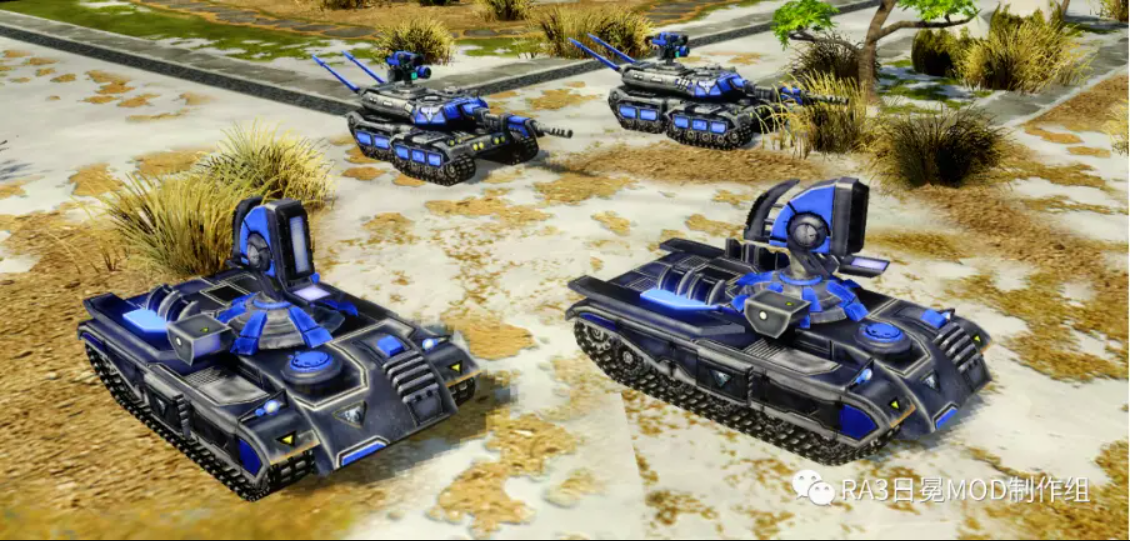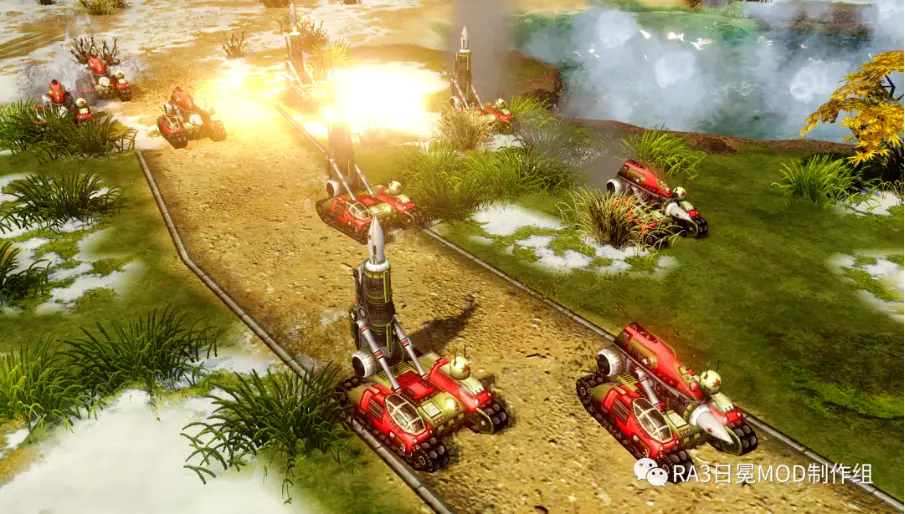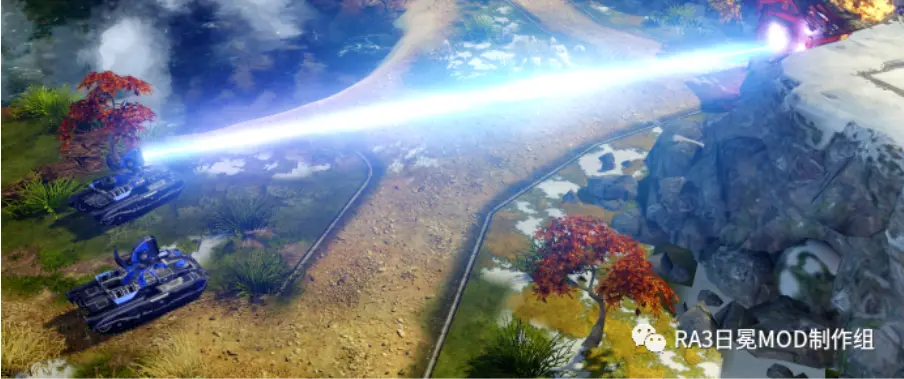Unit History – Prism Tank
Prism Tank (M1010 “Prism” Tank)
Designation: Advanced Fire Support Vehicle
National Origin: United States of Edenia/ Vereinigte Staaten von Edaenia
Designer: Raytheon, Carl Zeiss AG
Manufacturer: Raytheon
Mass-Produced at: Armor Facility
Key Features:
>> TLWS-85 “Aurora” Laser System
>> “Comet” Laser Refraction Prism
>> AN/ASQ-180 “White Eagle” Integrated Optoelectronics Devices
>> Maglev Flywheel Battery Pack
>> Vehicle Platform based on Grizzly Tank
>> Jailbreaking Guides for Visible Spectrum
Background
The European nations always have a sense of powerless when facing the enormous, transcontinental red bear. Few can foresee that tanks, once designed to overcome trenches and barbed wires during the European War, can pose such a huge to Allied nations in Europe. These powerful machines that are good at both offence and defence fit well with the nature of Slavs just like Cossack Cavalry. The new political system born in October Revolution also shows surprising versatility and does not collapse like many Western countries anticipated. Despite their hatred to this new political form and their argument of soviets threatening the freedom Europeans fought for since the Renaissance, it is well understood that the combination of communism, industry and Russian minerals is more than enough to bring apocalypse to the entire Europe, assuming the intelligence network and Russian propaganda are accurate.
Military Simulation by the Allies Senior Defence Committee (ASDC) shows that if the war breaks out, armoured vehicles will be manufactured from the factories in both Eastern Europe and Urals by thousands. The red army of steels will sweep Europe in matter of weeks. Europe’s only hope is the expedition force from the United States can arrive in time. However, it is questionable if the current military strength of European nations can withstand long enough until the reinforcement arrives. Even this prediction is under the premise that the giant in the East does not intervene.
Ironically, Celestial Empire, the opponent of the United States, provided the European countries critical insights on the development of Soviet armoured force. The brief conflict between the Soviet Union and Celestial Empire allowed the agents to send back many valuable data of Russian tanks. The latest data proved the concern. The outdated European tanks do not stand a chance when facing the new Rhino B Tank. The soviet armoured force can easily break through the line of defence since the expensive and complicated orbital defence network is yet to be completed. Under the unprecedented pressure, the Allies High Council urged the Entente du Rhin (Rheinische Entente) put the development projects of new generation main battle tank and tank destroyer to the highest priority, especially the project code name VK 45.14 “Arrow of Paris”.
Comparing to those European allies that are under the direct threat of soviet invasion, the United States is in a much more comfortable position. The two oceans make her free from most land invasion. Besides, the powerful navy in the East concerns the congress more than the pathetic Russian costal guards. But the Edenian politicians and military leaders know the importance of Europe. The Edenia will be a lone island of the free world if either the Soviet Union or Celestial Empire establishes dominance on the continents, with an almost negligible ally South Africa.
Considering the fact that the Edenian Expedition Force will eventually face the terrifying armoured force of the Soviet Union, the elite blue sea fleet of the Rising Sun and the mysterious army of the Celestial Empire, the government of United States constantly invests in the black hole of scientific research, hoping to yield breakthroughs that can benefit the arsenal of democracy. Now the hard works are paying back. Relying on the advanced technologies, the Allies will develop their own way to fight of the Soviet group troops.
The most important project will be a new generation main battle tank. The Allies High Council decided that a new standardised MBT will be the replacement of the current M8 Grizzly Tank. This project was handed over to highly experienced General Dynamics (GD) Land Systems. The British company Vickers joined the project as a partner to ensure the new tank can be a standardised MBT for all Allied nations. Eventually, this project became the now famous MBT-X8 Guardian Tank.
Along with the MBT-X8, the new multipurpose fire support system, MFSS-X1, was also started. The original purpose of the system was to provide mid-range fire support against lightly armoured targets or defensive structures, but the intelligence from Office of Strategic Services (OSS) pushed it to change. High resolution photos taken by the satellites verified the existence of Type IV tactical ballistic missile, i.e. the V4 missile. The European Division of Directorate of Plans (DDO) immediately took action and collected large amount of data of this new missile from Eastern Europe and Urals.
V-weapons, the German-originated, earliest missile series has been one of the most dangerous weapons in the Soviet arsenal since being stolen from Aachen. According to the calculation by Allies technical department, V4 is much superior to its predecessor V3 in many ways. Miniaturisation of the rocket engine and high-octane explosives give missile a compact hull. Optimised aerodynamics and radiation-absorbent material (RAM) can effectively reduce its infrared radiation signature. Redesigned trajectory makes its cruising and attacking pattern stealthier and more unpredictable.
The department report came to a worrying conclusion: “The multigunner IFV in the Allies formation is incapable of intercepting incoming Soviet Type IV tactical ballistic missile.” The United States super computer “Fulcrum” reinforced this conclusion: even with the radar system accurately locates and locks on the missile, a platoon of 6 IFVs only has about 14% interception success rate.
“Let’s be honest, it is practically nonexistent on the battlefield.” The major general ended his presentation with this phrase and a forced smile on his face. The report also threw a bomb into the Department of Defense (DoD). High rank Allies generals clearly cannot tolerate the existence of such a fatal weakness. The requirement of missile interception capability was soon added to the MFSS-X1 project. The army expected the new system capable of detecting and intercepting 2 V4 missiles or 6 rockets in given duration.
When the additional requirement was added, Norwell-Hucks Corporation and Angstrom Defense quitted the competition, since the former was already in trouble getting the YB2-X V/STOL bomber prototype fixed, while the latter almost threw their full might into the construction of the Orbital Defence Network.
The rest of the competitors, GD Land Systems and Raytheon both revealed their prototypes shortly after. The Raytheon’s prototype was announced as the winner of the competition, after closely examining both prototypes in Yakima test site, WA and Aberdeen Proving Ground, MD. The Raytheon’s laser weaponry outmatched GD’s traditional gun and missile system not only because of its excellent armour penetration and interception capability, but also because of low cost of the energy-based ammunitions. Although the total cost of the laser system is slightly higher than that of the traditional system, the General Board of the Allies Equipment believe that the laser system will benefit the logistics management in the long term.
To manufacture the prototype, Raytheon will need to integrate multiple subsystems into one reliable system with reasonable cost. In order to start the manufacture as soon as possible so that the weapon can catch up the progress of V4 launcher, Raytheon decided to launch the research on all subsystems simultaneously then finish the integration all at once. The decision was proved to be a double edged sword. Simultaneously developing all subsystem did save time and allow researchers to fix compatibility issues efficiently, but it also pushed the whole company to the limit. Many engineers had to take multiple positions and involve in interdepartmental works. A department manager even cancelled his trip to Australasia.
As the core of the whole weapon system, the laser subsystem was without a doubt the top priority. This project was assigned to the team led by Dr. Bernice Jones from CIT. She decided to use fibre laser instead of the deuterium fluoride laser as the source to further lower the cost. However, the army cannot supply sufficient rare-earth elements that the large scale manufacture of the active gain medium was required. To compensate this, Raytheon approached both Fenghou Corporation from the Celestial Empire and Allies High Council to acquire additional rare-earth elements supply. As expected, the intervention of the Division of Territory under the Celestial Ministry of Revenue prohibited Fenghou Corporation to sell such strategic resources to the United States. But fortunately, the Allies High Council allowed Raytheon to have the priority on purchasing rare-earth materials across Edenia.
With rare-earth materials from Canada and Kingdom of Brasilia satisfied the mass production, the first standardised model was tested soon after. The refraction prism was specially designed by Carl Zeiss AG with the code name “Comet”. The production variant laser was proven to be highly effective against most targets, including single layered armour. It could also severely damage the electronics by emitting electromagnetic radiation upon hitting. Moreover, the laser beam will be refracted by the target surface area, creating lethal “fragments” that will damage nearby units. This feature makes the system exceptionally destructive against infantry or clustered missiles. The system itself was given the name “Aurora”.
Raytheon chose the already matured AN/ASQ-180 “White Eagle” Comprehensive Target Acquisition and Designation System (CTADS) as the fire control system. This sophisticated and expensive system consisted of laser rangefinder, FLIR system, laser calibration system, Doppler radar, fire control radar and tactical data uplink. The system can not only accurately acquire and lock on targets, but also coordinate with other fire control systems by coupling with Allies Tactical Digital Information Link (TADIL). To ensure the combat efficiency in prolonged battle, additional Maglev flywheel battery pack was installed together with the weapon system. The battery pack can quickly recharge with very low energy loss when the vehicle engine was on. Theoretically, the battery pack can solely support the entire weapon system for 30 minutes without the generator running after 2 hours of recharge.
The complete version of laser weapon system has two attack modes. In anti-ground mode, the “Aurora” will continuously lock on and focus a specific target for 5 second as an attack round. This mode can effectively damage lightly armoured units and fortifications. In anti-air mode, the “Aurora” will receive all the power supply it can get from the platform. Under the guidance of “White Eagle” CTADS, the laser can burst down most missiles and rockets. However neither can the “White Eagle” track nor can the “Aurora” fire at targets flying at high altitude.
[Prism Tank Deploying to Intercept Missiles]*
[Intercepting Incoming Missiles]
Although the limited maximum power (as most Allies mobile platform cannot provide any higher power supply) prevented the MFSS-X1 to be a direct fire platform that is able to counter heavily armoured target, the current state of this system is already fulfilled its role as a fire support and missile defence vehicle.
[Attacking Heavy Armour is not Prism Tank’s Strength]
[Prism Tank Attacking Defensive Structures]
The Allies High Council and the General Board of the Allies Equipment approved the mass production of MFSS-X1 after all the trials were completed successfully. The designation M1010 was given. Later, the nickname “Prism” was made official. The Allies formation was also adjusted, allowing each mechanised infantry battalion to contain one Multipurpose Laser Weapon (MLW) platoon. When the first order of 120 M1010 was confirmed, the entire research team partied for the whole night. Few were aware their hard works behind this success.
It is worth to point out that to achieve the designed range and striking power, the monocoloured laser is usually set at the frequency invisible to human eyes. But it will be captured and colourised on the command terminal to help army commanders evaluate the battle. This is one of the unique functions of the new Global Combat Command System.
After Prism Tank entered service, a weapon operator named George Hotz successfully unlocked the computer system lock and reached the internal maximum wave length of the laser generator: 465nm. He called this “Jailbreaking”. Well within the visible light range (blue), the soldiers can utilise their smoke grenades (or other smoke generators) to create scattering. It was quite amused to watch during the night, especially during Christmas Eve. But the most important application of the Prism Tank, is the sterilization and disinfection usage like ultraviolet lamps. It is much easier and safer than any chemicals.
Additionally, considering the high cost of the original M1010, Raytheon decided to cooperate with the United States Army and obtained the retired hull of M8 Grizzly Tank. The new variant of Prism Tank has lower cost and shorter production time.
When the war broke out, United States Army was full equipped with Prism Tank. Many European countries also bought Prism Tank as a missile defence platform. The United Kingdom even obtained license to modify their own Grizzly Tanks. These Prism Tanks are used as base defence units for Royal Air Force.
[Prism Tank Excels at Attacking Light Units]
Since then, Prism Tank participated the war as one of the most efficient fire support units. They could be found in every battle, and earned their reputation among most Allies soldiers.
Notes from the Field
Battlefield reconnaissance has revealed at least these facts about the Prism Tank:
Fire Support Backbone -- Prism Tank is relatively easy to deploy comparing to other fire support vehicles. Allies commander only need to obtain Heightened Clearance to assemble Prism Tank in the Armour Facility.
Goddess of Dawn -- The “Aurora” laser weapon system is very effective against lightly armoured targets, but is mediocre to heavily armour vehicles or structures. Though the laser can shoot infinitely far until the absorption and scattering kick in, there is still a range limit for the fire control system to calibrate the effect of thermal blooming, the latter prevents the weapon to aim accurately.
Shining Fragments -- The laser beam firing from “Aurora” is so intense, that the scattering beams after hitting the target surface are also quite destructive. Multiple Prism Tanks can easily wipe out a group of infantry or vehicles with the aid of these “fragments”.
Guardian Angel -- The Prism Tank can be deployed as a stationary missile interception platform by diverting all the power supply to the weapon system. Multiple Prism Tanks can form a durable anti-missile bubble. The manual underlines that this system is NOT designed to attack aircrafts of any kind.
*Unfortunately we cannot insert .gif files larger than 4MB. For those pictures, please visit Bilibili.com to check it out.
Corona Development Team
Written by: Ninghai
Edited by: CQ
Translated by: Mirage in the Void






******* Prism Tank!
My favourite unit from RA2. Clearing out Communism with a giant, focused flashlight.
your mod is so high quality. keep it up! :)
yo, that prism tank is a masterpiece!
prism tank is my favorite too!!!
good job guys!
do you have release date?
They are trying to have a second test at the second-half year.
BTW,they forgot to update in YT,if you can find their page in Bilibili,they have made some progress.
I'm glad to see the return of one of the best tanks for the Allies, and great work like always!
Looks fantastic
This comment is currently awaiting admin approval, join now to view.
来了来了
a the Red Alert 2 Prism tanks.
This comment is currently awaiting admin approval, join now to view.